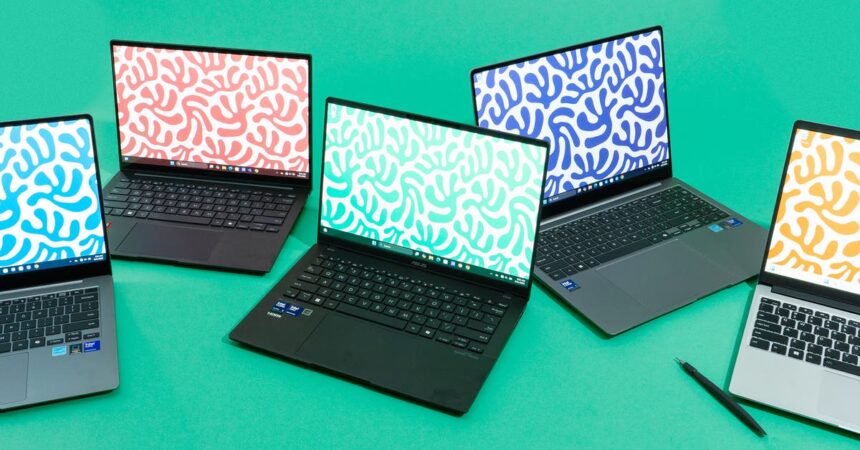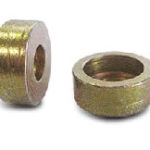The Asus Zenbook 14 (UM3406KA-PS76T) is similar in design to our budget pick, with a 14-inch OLED touch display, the same keyboard and trackpad, and around 14.5 hours of battery life. Stock has been unreliable, and it doesn’t have the latest version of Wi-Fi or Thunderbolt 4 ports, but it’s still a solid laptop if our picks are unavailable.
Compared with our top pick, the Asus Vivobook S 14 (M5406WA-BS99) provides better performance, including for light gaming, but it’s otherwise largely identical — same OLED display, same RGB keyboard, and so on. This model comes with a bulkier charger and has shorter battery life, lasting 13 hours 15 minutes in our tests.
The Framework Laptop 13 (Intel Core Ultra Series 1) was our former repairable pick, and it’s still a solid option if you see it on sale. The base model has only 8 GB of memory — though adding more is easy — and its battery life isn’t quite as long.
The Lenovo ThinkPad X1 Carbon Gen 12 was our former upgrade pick, and it remains a nearly perfect, though expensive, laptop. The X1 Carbon Gen 12 is even lighter than our top pick, it’s available in a variety of configurations depending on your needs, and it has a more comfortable keyboard and a fingerprint reader. We plan to retest its successor, the X1 Carbon Gen 13, for our next update now that it’s available in more configuration options.
The Asus Zenbook S 14 (UX5406SA-S14.U71TB) is a svelte laptop with a stylish brutalist design, a 14-inch 2880×1800 OLED touchscreen, solid performance, and 14.5 hours of battery life. But it’s expensive at $1,400, and in our tests we experienced throttling under heavy workloads.
Although the Lenovo ThinkPad X9 14 Aura Edition (14″ Intel) has the best haptic trackpad I’ve tested so far in a Windows laptop, it lacks a webcam cover and USB-A ports, it’s heavier than the similarly priced ThinkPad X1 Carbon, and its keyboard isn’t as spacious.
The Microsoft Surface Laptop (7th Edition, 13.8 inch) is available with Intel’s Lunar Lake processors, but it’s too expensive: It starts at $1,500 for a configuration with 256 GB of storage.
The LG Gram 14″ 2-in-1 (14T90S-G.AAB4U1) and LG Gram 14″ (14Z90T-G.AAB2U1) are thin-and-light laptops with excellent battery life, but in our tests their lids exhibited a concerning amount of flex. In addition, both models come with a ton of bloatware and cost more than our top pick.
The Acer Swift 14 AI (SF14-61T-R49D) is pricier, thicker, and heavier than our top pick, and in our tests its fans ran constantly at a distracting volume. It also comes packed with excessive bloatware.
The Acer Swift 14 AI (SF14-51T-75AF) lasted 20.5 hours in our battery life test, but it comes with too much bloatware, its speakers are awful, its webcam looks blurry, and it has a distracting and unnecessary illuminated AI logo on its trackpad.
In our tests, the Asus ExpertBook P5 (P5405CSA)’s display had a blue cast and poor viewing angles, and its loose hinge caused the display to sag when we moved the laptop.
The Asus Zenbook 14 OLED (Q425MA-U71TB) is similar to our budget pick, but in our testing we experienced aggressive throttling on this laptop’s processor.
The Dell XPS 13 (9350) has a finicky touchpad and a limited port selection.
The HP Envy x360 14-Inch 2-in-1 (14t-fc000) had short battery life in comparison with our picks.
The lid of the LG Gram 14″ (14Z90S-G.ARW3U1) flexed under light pressure. This laptop is not available with 16 GB of memory at this writing, and it comes loaded with bloatware.
The Lenovo Yoga Slim 9i (14″ Intel) achieves a uniquely thin bezel by hiding its 32-megapixel webcam beneath the display. But this webcam looked worse than equivalent 1080p webcams, and it particularly struggled with light sources in the background. This model is also expensive, lacking a headphone jack, and difficult to open with a single hand.
The dual-screen Asus Zenbook Duo (UX8406CA) is an interesting experiment, with two displays and a detachable slab that contains the keyboard and trackpad. This design makes it heavy in comparison with our picks, at 3.64 pounds. And its battery life fell far short: When we used only the top display and the attached keyboard, it lasted 11 hours 15 minutes in our battery tests, and when we used both displays — one to browse the web and the other as an on-screen keyboard and trackpad — it died in just 7.5 hours. If you need more display than a traditional laptop offers, I recommend getting one of our top picks and a portable monitor instead.
The Asus Zenbook 14 OLED (UX3405) is similar to our budget pick but has an Intel Core Ultra 7 155H processor and 32 GB of memory. We experienced aggressive throttling on this processor, and this laptop had about four hours less battery life than our recommended AMD-based model.
The HP Spectre x360 (14t-eu000) is heavy at 3.19 pounds. It fell hours short of our picks in battery life, and it’s expensive. We experienced intermittent throttling on this model, as well.
The Lenovo Yoga 9i 2-in-1 (14″ Intel) had subpar battery life, lasting just 9 hours 25 minutes in our battery test. (We test laptops at 60 Hz, and the Yoga 9i’s default refresh rate is 120 Hz, which takes another hour or so off.) The Yoga 9i has an excellent screen, superb build quality, a 5-megapixel webcam, impressive speakers, and a 360-degree hinge. But none of those features are useful if your laptop’s battery is dead.
Budget options
The Acer Aspire 14 AI (A14-52M/A14-52MT) is larger and heavier than our budget pick, and its display looks dim and washed out. It also comes with a ton of bloatware.
Compared with our budget pick, the Acer Swift Go 14 (SFG14-72-53BP) costs more, and it lasted five hours less in our battery tests.
The Asus Vivobook 14 (M1407KA-PS74) is heavy, its display looks washed out, and its battery life was abysmal in our tests.
The Asus Zenbook 14 OLED (Q415MA-U5512) costs as much as our budget pick but has less memory, and we experienced aggressive throttling on the processor.
The HP Pavilion Aero (13z-bg000) had poor battery life, falling six hours short of our budget pick. And although it’s especially light at 2.2 pounds, it feels flimsy.
At 3.55 pounds, the Lenovo Yoga 7 2-in-1 (14″ AMD) is particularly heavy. And its display doesn’t get as bright as those of our picks.
The Microsoft Surface Laptop Go 3 has a small, low-resolution display, and its battery life isn’t long enough to survive a full day of work or classes.
Big-screen options
The Lenovo Yoga Slim 7i Aura Edition (15″ Intel) has 16.5 hours of battery life, but its 15.3-inch display isn’t OLED, its trackpad struggled with palm rejection in our tests, and it’s difficult to open with one hand.
The Acer Swift Go 16 AI (SF16-51T-76TG) comes with a ton of bloatware, its build quality fails to match that of our picks, and its display is highly reflective.
Lasting around 11 hours in our tests, the Asus Vivobook S16 (M5606KA-PS77) had mediocre battery life. It also had some noticeable flex in the lid and keyboard deck.
Our top pick provides a larger screen, better build quality, and longer battery life for the same price as the LG Gram 15.6″ (15Z90T-H.AAB4U1).
The Lenovo Yoga 7i 2-in-1 (16″ Intel) is especially heavy at 4.23 pounds, and in our tests its display was dim, with a sickly yellow-green cast.
The $1,700 LG Gram 16″ (16Z90TL) posted a long battery life of 18 hours in our tests, but we found a concerning amount of flex in the lid and keyboard deck, and its keyboard felt shallow and mushy.
The LG Gram Pro 16″ 2-in-1 (16T90TP-K.AAB4U1) is very expensive at $2,000 and had mediocre battery life of 11 hours 22 minutes in our testing.
Snapdragon options
Because Snapdragon processors don’t use the x86 architecture that has been standard on Windows PCs for decades, laptops based on these processors are currently in a transition period similar to when MacBooks moved to Apple Silicon processors. Support is improving, and Microsoft’s app-translation layer, Prism, runs x86 apps moderately well but not entirely without hiccups — some apps and peripherals won’t work until developers build an Arm version, and you can get excellent battery life now in a Windows laptop without those limitations.
The Microsoft Surface Laptop (7th Edition, 13.8 inch) is the best Snapdragon laptop we’ve tested so far, with a compact design and nearly 16 hours of battery life in our tests. But Microsoft recently discontinued the base model we recommended, and now the cheapest option starts at $1,200.
The HP OmniBook X lasted 14 hours 20 minutes in our battery tests and has an excellent 5-megapixel webcam. But it’s more expensive than the Surface, its speakers aren’t great, and its display doesn’t get as bright.
The Lenovo Yoga Slim 7x has a vivid, bright 14.5-inch OLED display and is still svelte and sturdy — the whole laptop weighs just 2.82 pounds and offers excellent build quality and 17 hours of battery life. But it lacks a headphone jack and USB-A ports and doesn’t come with any dongles for its three USB-C ports.
The Dell XPS 13 (9345) has ridiculous battery life — it lasted 21 hours 31 minutes in our tests — and it’s a thin-and-light laptop with excellent build quality. But its haptic trackpad continues to be finicky (an issue we’ve experienced on other recent iterations of the XPS 13), and it still lacks a headphone jack.
Compared with the other Snapdragon laptops we tested, the Dell Inspiron 14 Plus (7441) is heavier, it doesn’t feel as premium, and its speakers aren’t great.
The Acer Swift 14 AI (SF14-11T) has a mushy-feeling keyboard and trackpad, comes with a ton of bloatware, and sports a distracting and unnecessary illuminated AI logo on its trackpad.
The Samsung Galaxy Book4 Edge (14″) is more expensive than comparable Snapdragon-based laptops we tested, and its 11.5-hour battery life was no match for the superb results we saw from other Snapdragon machines.
The Asus Zenbook A14 (UX3407QA-PS76) and (UX3407QA-X1P512) cost more than the Microsoft Surface Laptop for a weaker processor and no touchscreen. The A14 is a fine computer, but the Surface Laptop is a better value.
The Lenovo IdeaPad 5 2-in-1 14Q8X9 (83GH0002US) has shorter battery life than the Surface Laptop 13, and the Acer Swift Go 14 AI (SFG14-01-X006)’s display lacks touch and has a yellow tint. Both models also have a slower Snapdragon X Plus XIP-42-100 processor than our recommended Surface Laptop 13 configuration does; it’s fast enough for everyday tasks, but these models aren’t inexpensive enough to justify the drop in performance.
This article was edited by Caitlin McGarry and Arthur Gies.

























